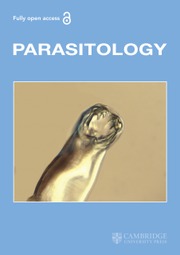Crossref Citations
This article has been cited by the following publications. This list is generated based on data provided by
Crossref.
Tinsley, R. C.
1999.
Parasite adaptation to extreme conditions in a desert environment.
Parasitology,
Vol. 119,
Issue. S1,
p.
S31.
Tinsley, R. C.
1999.
Overview: extreme environments.
Parasitology,
Vol. 119,
Issue. S1,
p.
S1.
Cable, Joanne
and
Tinsley, Richard C.
2001.
Ultrastructure of spermiogenesis and spermatozoa of Discocotyle sagittata (Monogenea: Polyopisthocotylea: Discocotylinea).
Folia Parasitologica,
Vol. 48,
Issue. 3,
p.
209.
Rubio-Godoy, Miguel
and
Tinsley, Richard C.
2002.
Trickle and single infection with Discocotyle sagittata (Monogenea: Polyopisthocotylea): effect of exposure mode on parasite abundance and development.
Folia Parasitologica,
Vol. 49,
Issue. 4,
p.
269.
Tinsley, R C
2004.
Platyhelminth parasite reproduction: some general principles derived from monogeneans.
Canadian Journal of Zoology,
Vol. 82,
Issue. 2,
p.
270.
Viozzi, Gustavo P.
Semenas, Liliana G.
and
Gutiérrez, Pablo
2005.
POPULATION DYNAMICS OF PHILURETER TRIGONIOPSIS (MONOGENEA: ANCYROCEPHALINAE) FROM URINARY ORGANS OF GALAXIAS MACULATUS (OSMERIFORMES: GALAXIIDAE) IN A COLD TEMPERATE ANDEAN PATAGONIAN LAKE (ARGENTINA).
Journal of Parasitology,
Vol. 91,
Issue. 6,
p.
1368.
Fels, Daniel
and
Kaltz, Oliver
2006.
Temperature-dependent transmission and latency ofHolospora undulata, a micronucleus-specific parasite of the ciliateParamecium caudatum.
Proceedings of the Royal Society B: Biological Sciences,
Vol. 273,
Issue. 1589,
p.
1031.
Mooney, A.J.
Ernst, I.
and
Whittington, I.D.
2006.
An egg-laying rhythm in Zeuxapta seriolae (Monogenea: Heteraxinidae), a gill parasite of yellowtail kingfish (Seriola lalandi).
Aquaculture,
Vol. 253,
Issue. 1-4,
p.
10.
Rubio-Godoy, Miguel
and
Tinsley, Richard C.
2008.
Recruitment and effects of Discocotyle sagittata (Monogenea) infection on farmed trout.
Aquaculture,
Vol. 274,
Issue. 1,
p.
15.
Baker, Tiffany G.
Pante, Eric
Levesque, Erin M.
Roumillat, William A.
and
de Buron, Isaure
2008.
Metamicrocotyla macracantha, a polyopisthocotylid gill parasite of the striped mullet, Mugil cephalus: population dynamics in South Carolina estuaries.
Parasitology Research,
Vol. 102,
Issue. 5,
p.
1085.
Rubio-Godoy, Miguel
and
Tinsley, Richard C.
2008.
Transmission dynamics of Discocotyle sagittata (Monogenea) in farmed rainbow trout interpreted from parasite population age structure.
Aquaculture,
Vol. 275,
Issue. 1-4,
p.
34.
Viozzi, G. P.
and
Semenas, L. G.
2009.
Do Environmental Differences Between Lakes in Northwestern Argentinean Patagonia Affect the Infection of Philureter trigoniopsis (Monogenea) in Galaxias maculatus (Osmeriformes)?.
Journal of Parasitology,
Vol. 95,
Issue. 1,
p.
25.
Rábago‐Castro, Jaime
Sánchez‐Martínez, Jesús Genaro
Loredo‐Osti, Jorge
Gomez‐Flores, Ricardo
Tamez‐Guerra, Patricia
and
Ramírez‐Pfeiffer, Carlos
2011.
Temporal and Spatial Variations of Ectoparasites on Cage‐reared Channel Catfish, Ictalurus punctatus, in Tamaulipas, Mexico.
Journal of the World Aquaculture Society,
Vol. 42,
Issue. 3,
p.
406.
Muñoz, Gabriela
and
Randhawa, Haseeb S.
2011.
Monthly variation in the parasite communities of the intertidal fish Scartichthys viridis (Blenniidae) from central Chile: are there seasonal patterns?.
Parasitology Research,
Vol. 109,
Issue. 1,
p.
53.
Repullés-Albelda, Aigües
Holzer, Astrid S.
Raga, Juan A.
and
Montero, Francisco E.
2012.
Oncomiracidial development, survival and swimming behaviour of the monogenean Sparicotyle chrysophrii (Van Beneden and Hesse, 1863).
Aquaculture,
Vol. 338-341,
Issue. ,
p.
47.
Shah, Humaira Bashir
Yousuf, A. R.
Chishti, M. Z.
and
Ahmad, Fayaz
2013.
Seasonal changes in infrapopulations of Diplozoon kashmirensis Kaw, 1950 (Monogenea: Diplozoidae) along a eutrophic gradient.
Parasitology Research,
Vol. 112,
Issue. 9,
p.
3347.
El Hafidi, Fouzia
Rkhami, Ouafae Berrada
de Buron, Isaure
Durand, Jean-Dominique
and
Pariselle, Antoine
2013.
Ligophorus species (Monogenea: Ancyrocephalidae) from Mugil cephalus (Teleostei: Mugilidae) off Morocco with the description of a new species and remarks about the use of Ligophorus spp. as biological markers of host populations.
Folia Parasitologica,
Vol. 60,
Issue. 5,
p.
433.
Repullés-Albelda, Aigües
Kostadinova, Aneta
Raga, Juan Antonio
and
Montero, Francisco E.
2013.
Seasonal population dynamics of Zeuxapta seriolae (Monogenea: Heteraxinidae) parasitising Seriola dumerili (Carangidae) in the Western Mediterranean.
Veterinary Parasitology,
Vol. 193,
Issue. 1-3,
p.
163.
Mello, Giovanni Lemos de
Jerônimo, Gabriela Tomas
Tancredo, Karen Roberta
Brol, Jéssica
Almeida, Evelyn Jacques de
Martins, Maurício Laterça
and
Tsuzuki, Mônica Yumi
2015.
Development and health status of Centropomus undecimalisparasitized by Rhabdosynochus rhabdosynochus (Monogenea) under different salinity and temperature conditions.
Revista Brasileira de Parasitologia Veterinária,
Vol. 24,
Issue. 3,
p.
350.
Marchiori, N. C.
Gonçalves, E. L. T.
Tancredo, K. R.
Pereira-Junior, J.
Garcia, J. R. E.
and
Martins, M. L.
2015.
Effect of water temperature and salinity in oviposition, hatching success and infestation of Aphanoblastella mastigatus (Monogenea, Dactylogyridae) on Rhamdia quelen.
Brazilian Journal of Biology,
Vol. 75,
Issue. 4 suppl 1,
p.
245.

